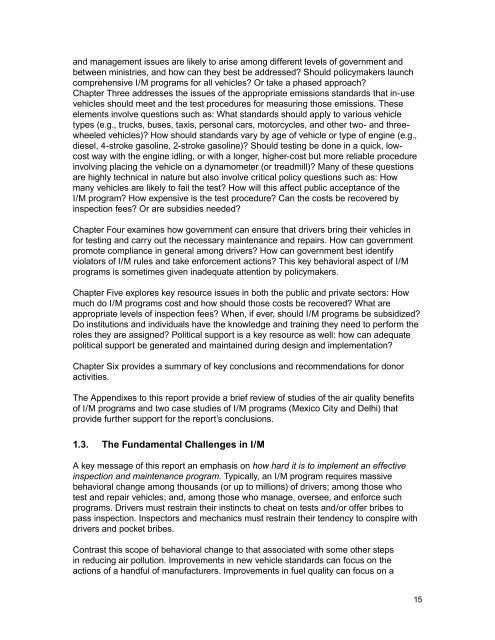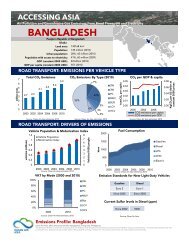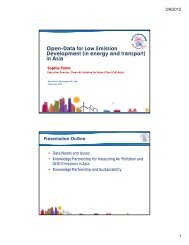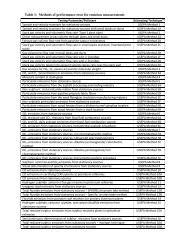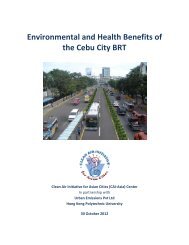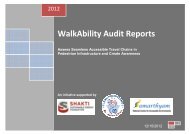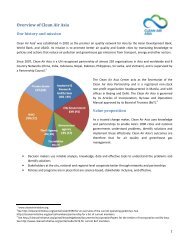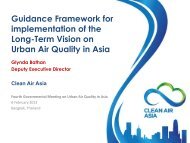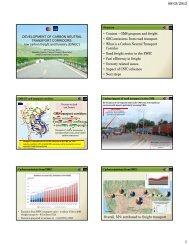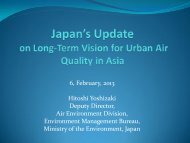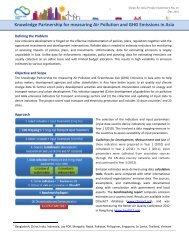International Experience and Best Practices - Clean Air Initiative
International Experience and Best Practices - Clean Air Initiative
International Experience and Best Practices - Clean Air Initiative
You also want an ePaper? Increase the reach of your titles
YUMPU automatically turns print PDFs into web optimized ePapers that Google loves.
<strong>and</strong> management issues are likely to arise among different levels of government <strong>and</strong><br />
between ministries, <strong>and</strong> how can they best be addressed? Should policymakers launch<br />
comprehensive I/M programs for all vehicles? Or take a phased approach?<br />
Chapter Three addresses the issues of the appropriate emissions st<strong>and</strong>ards that in-use<br />
vehicles should meet <strong>and</strong> the test procedures for measuring those emissions. These<br />
elements involve questions such as: What st<strong>and</strong>ards should apply to various vehicle<br />
types (e.g., trucks, buses, taxis, personal cars, motorcycles, <strong>and</strong> other two- <strong>and</strong> threewheeled<br />
vehicles)? How should st<strong>and</strong>ards vary by age of vehicle or type of engine (e.g.,<br />
diesel, 4-stroke gasoline, 2-stroke gasoline)? Should testing be done in a quick, lowcost<br />
way with the engine idling, or with a longer, higher-cost but more reliable procedure<br />
involving placing the vehicle on a dynamometer (or treadmill)? Many of these questions<br />
are highly technical in nature but also involve critical policy questions such as: How<br />
many vehicles are likely to fail the test? How will this affect public acceptance of the<br />
I/M program? How expensive is the test procedure? Can the costs be recovered by<br />
inspection fees? Or are subsidies needed?<br />
Chapter Four examines how government can ensure that drivers bring their vehicles in<br />
for testing <strong>and</strong> carry out the necessary maintenance <strong>and</strong> repairs. How can government<br />
promote compliance in general among drivers? How can government best identify<br />
violators of I/M rules <strong>and</strong> take enforcement actions? This key behavioral aspect of I/M<br />
programs is sometimes given inadequate attention by policymakers.<br />
Chapter Five explores key resource issues in both the public <strong>and</strong> private sectors: How<br />
much do I/M programs cost <strong>and</strong> how should those costs be recovered? What are<br />
appropriate levels of inspection fees? When, if ever, should I/M programs be subsidized?<br />
Do institutions <strong>and</strong> individuals have the knowledge <strong>and</strong> training they need to perform the<br />
roles they are assigned? Political support is a key resource as well: how can adequate<br />
political support be generated <strong>and</strong> maintained during design <strong>and</strong> implementation?<br />
Chapter Six provides a summary of key conclusions <strong>and</strong> recommendations for donor<br />
activities.<br />
The Appendixes to this report provide a brief review of studies of the air quality benefits<br />
of I/M programs <strong>and</strong> two case studies of I/M programs (Mexico City <strong>and</strong> Delhi) that<br />
provide further support for the report’s conclusions.<br />
1.3. The Fundamental Challenges in I/M<br />
A key message of this report an emphasis on how hard it is to implement an effective<br />
inspection <strong>and</strong> maintenance program. Typically, an I/M program requires massive<br />
behavioral change among thous<strong>and</strong>s (or up to millions) of drivers; among those who<br />
test <strong>and</strong> repair vehicles; <strong>and</strong>, among those who manage, oversee, <strong>and</strong> enforce such<br />
programs. Drivers must restrain their instincts to cheat on tests <strong>and</strong>/or offer bribes to<br />
pass inspection. Inspectors <strong>and</strong> mechanics must restrain their tendency to conspire with<br />
drivers <strong>and</strong> pocket bribes.<br />
Contrast this scope of behavioral change to that associated with some other steps<br />
in reducing air pollution. Improvements in new vehicle st<strong>and</strong>ards can focus on the<br />
actions of a h<strong>and</strong>ful of manufacturers. Improvements in fuel quality can focus on a<br />
15


